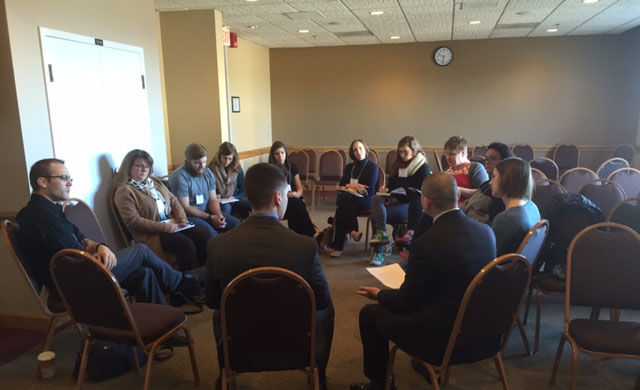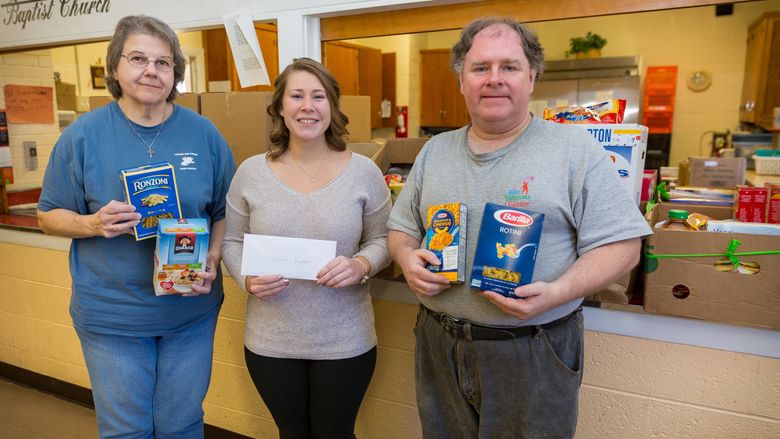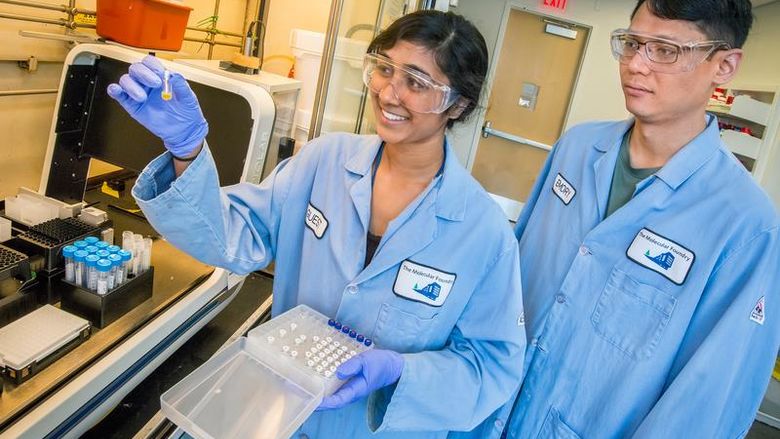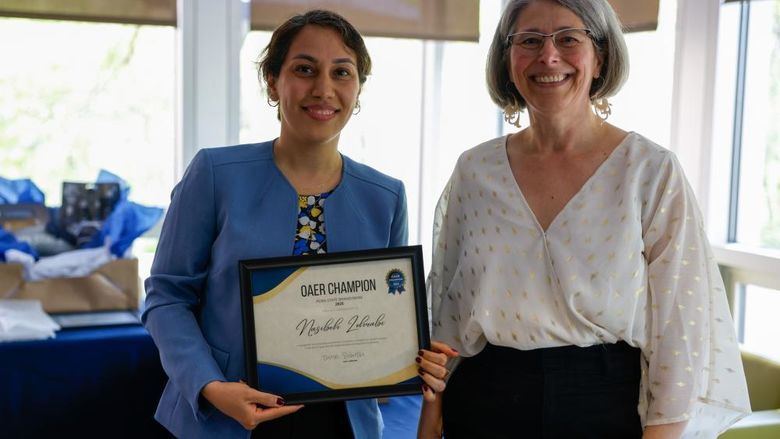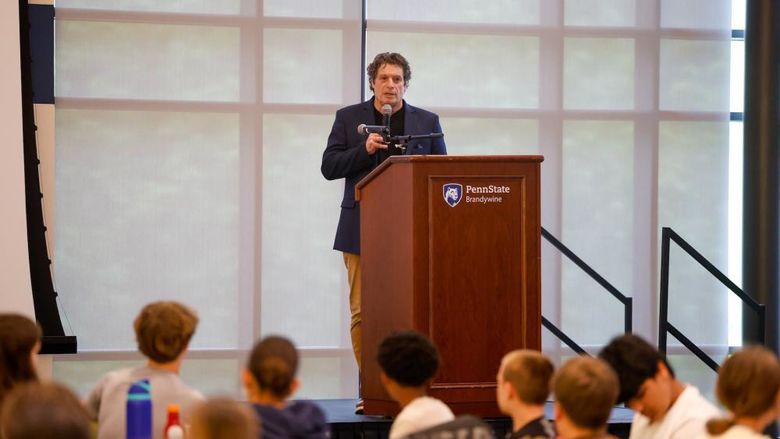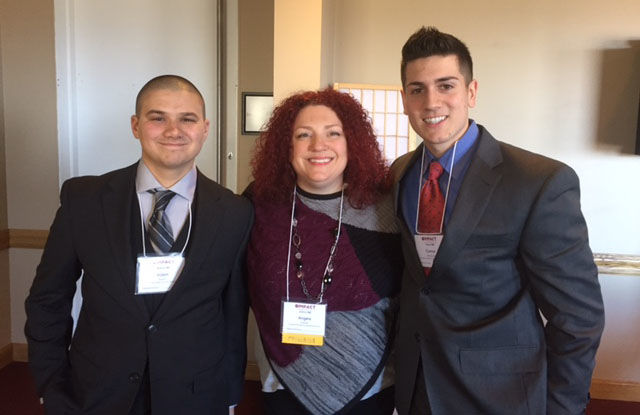
Adam Bivens, left, and Connor Harootunian, both Penn State Brandywine students, along with Angela Putman, assistant professor of communications arts and sciences, presented at the 2016 Impact Conference about how to create a public speaking college course around social justice.
MEDIA, Pa. — Penn State Brandywine students Adam Bivens and Connor Harootunian, along with Angela Putman, assistant professor of communication arts and sciences, presented at the 2016 IMPACT National Conference about how to create a public speaking college course around social justice.
Bivens and Harootunian, along with Timothy McDonald, who is currently studying at University Park and was unable to attend the conference, took Putman’s CAS 100 Effective Speech course at Brandywine during the fall 2015 semester.
“The course I teach is a little different than other CAS 100 courses,” Putman said. “The class is geared toward social justice and meant to be hands-on and interactive. In addition to learning and rehearsing formal public speaking skills, students are to pick a social injustice issue they are passionate about or have an interest in and present it throughout the semester to the class.”
For some students, the idea of picking a topic came easily, but for others who didn’t have a particular issue in mind, Putman asked them to answer, “When I look at the world, ‘blank’ makes me angry or sad.”
The course allowed students to think about a topic on a smaller scale, with the hope passion will carry over to future semesters and eventually enable each student to become a well-rounded global citizen who is passionate about standing up for a cause.
During the semester, Putman received information about the IMPACT conference. According to its website, the conference is historically the largest annual gathering focused on the civic engagement of college students in community service, service learning, community-based research, advocacy and other forms of social action. Once a year, students, administrators, faculty, AmeriCorps members and nonprofit professionals gather together to learn and share effective practices, improve personal skills and organizational strategies, discover opportunities and resources and exchange stories.
Putman invited her students to contact her if they were interested in presenting at the conference, and Bivens, Harootunian and McDonald expressed interest in presenting and attending the conference at the University of Massachusetts in Amherst.
“I had never been to a conference or to a big campus like that,” Bivens said. “I responded to Dr. Putman’s email, because I wanted to experience something different and get out of my comfort zone.”
With Putman’s guidance, the three students planned and presented “Utilizing a Social Justice Perspective and Framework in a College-level Public Speaking Course.” This was an interactive, roundtable-style workshop that shared a successful model for teaching a beginning-level public speaking class that used a social justice framework and perspective.
The students met with Putman several times prior to the conference. Since McDonald had already transitioned to University Park, he attended the meetings by Skype.
The lecture began with Putman’s pedagogical rationale, goals and outcomes for her course, as well as success stories that have come along with overhauling a traditionally taught public speaking course that incorporates advocacy and civic engagement.
Then, Bivens and Harootunian shared their personal perspectives and experiences, which lead to a roundtable discussion.
“The original plan was to have three separate roundtable discussions, but due to the size of the audience we decided it made more sense to discuss all three topics together as one group,” Putman said. “I was really proud of the students. They adjusted to the last-minute change very well and learned how to problem-solve on the spot.”
After some shifting, Putman, who stood in for McDonald, talked about how taking a communications course centered around social justice issues enables a student to more effectively convey research on a social-justice topic in order to broaden the appeal to a wider audience. Harootunian spoke about how the knowledge and experiences from this course can enable a student to become involved in a nonprofit organization or social entrepreneurship. Additionally, he discussed why a student should advocate for social change while understanding the importance of differentiating oneself from others in an equality-conscious world. Finally, Bivens shared how a student can work to foster activism inside and outside the classroom. He also added how activism instills civic-mindedness in students and encourages leadership and mindfulness beyond what students can see directly.
“Throughout the entire process the students took this experience very seriously and did a great job,” Putman said. “This experience gave the students a better sense of what can be learned by attending and presenting at a conference and how students receive the great benefit of advancing their college and professional career.”
Putman hopes to bring more students to future conferences to share the benefits and experience.
“I really want to continue attending and presenting at conferences,” Bivens said. “I got to meet a variety of different students from all over the world and meet other student activists and get a sense of different methods to be civically engaged and break barriers when talking about something you’re passionate about. At the conference, I wanted to share with other students how important it is to care about something you’re passionate about, and I hope that those students are like me and take their passion beyond the classroom to make a difference.”
